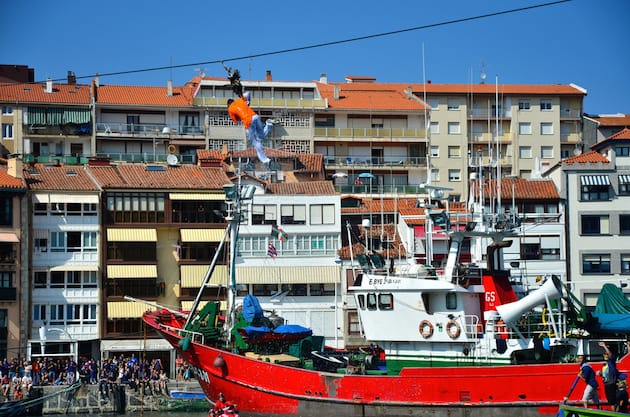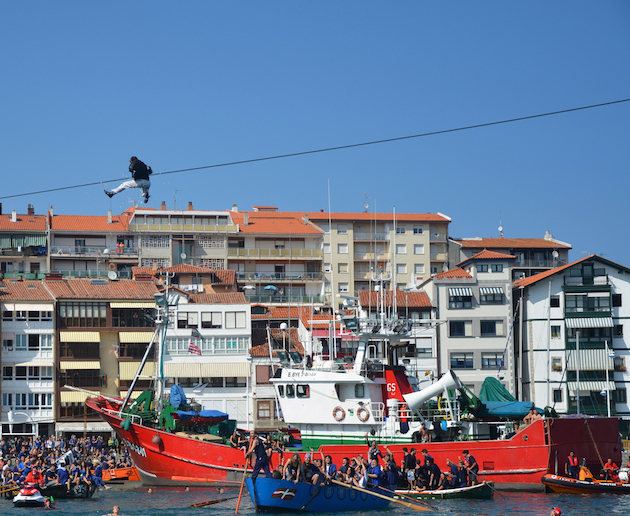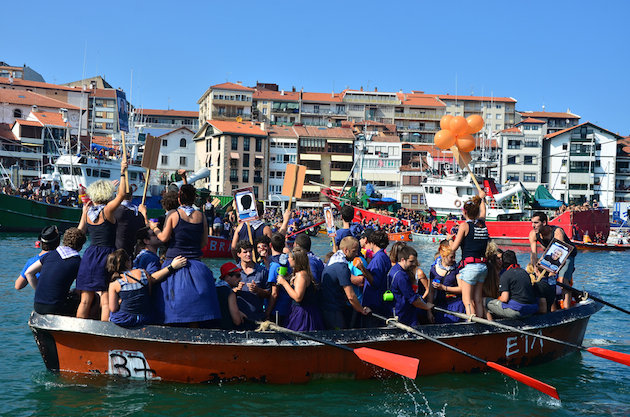Day of the Goose
Small towns around Europe host goose-pulling days—contests to snap the necks of birds at high speed. In the name of sport and pride, a tradition from the Middle Ages prospers, criticism notwithstanding.

Since at least 1666, the fifth of September has been a day of reckoning for geese in Lekeitio, a picturesque Basque fishing port on the Bay of Biscay.
Every year, intrepid men and women leap off of boats, hurling their bodies onto a dead goose that hangs from a sturdy rope strung across the harbor. As they hang onto the goose for dear life, the goal is to snap its neck. On its own, this requires a certain amount of dexterity, but a team of 20 strong men standing on the quay make the task even more difficult. When the jumper first grasps the goose, a caller on the quay yells “Tira!”—Basque for “pull!”—and the men forcefully yank the rope through a pulley. As it loses its slack, the jumper, still grappling to perform the decapitation, is catapulted up to six stories in the air before being shot back down into the water, as the pullers yank the rope back and forth.
When I read about the Día de los Gansos, or Day of the Geese, part of Lekeitio’s nine-day San Antolin Festival, prior to a recent trip to the Basque Country, I cringed. Breaking the necks of dead geese? I’m not a member of PETA, but I love animals and couldn’t understand the appeal of this seemingly gruesome spectacle. But I was also curious to learn more about this peculiar tradition, so on September 5, I made the hour and a half drive from San Sebastian along the Basque Coast to see the Day of the Geese for myself.
Goose-pulling has been a part of cultural celebrations in Europe since at least the Middle Ages. The Dutch brought it to New Amsterdam (New York) in the 17th Century. Peter Stuyvesant, the colony’s director general, banned the practice in 1656, calling it “unprofitable, heathenish, and pernicious.” But the practice continued in other parts of the US, mostly in the rural south.
Augustus Baldwin Longstreet published a detailed description of a goose-pull that took place with live geese in Augusta, Ga., in 1798 in his book Georgia Scenes, Characters and Incidents in the First Half of the Republic, published in 1859.
A circular path of about 40 yards in diameter had already been laid out; over which, from two posts about 10 feet apart, stretched a rope, the middle of which was directly over the path. The rope hung loosely, so as to allow it, with the weight of a gander attached to it, to vibrate in an arc of four or five feet span and so as to bring the breast of the gander within barely easy reach of a man of middle stature upon a horse of common size.
Pullers at this contest paid 25 cents each for a go at a gander whose neck had been greased for the occasion, and the winner, the man who was the first to snap its neck, took home the pot. The practice, which appears to have been equal parts social occasion and gambling/sporting activity, died out in the US shortly after the Civil War.
But in Europe, goose-pulling continues to thrive. Travelers in search of an offbeat, if not macabre experience can find goose-pulling events at more than a dozen festivals in Belgium, The Netherlands, Germany, Switzerland, France, Italy, and Spain from February through November.
In many places, goose-pullers attempt to snap a goose’s neck while riding by at full speed on horseback. Lekeitio, in a nod to its seafaring tradition, is apparently the only place where the spectacle takes place on the water. Geese are used at most of the festivals, though in Tonco, Italy they use turkeys, and in Saint-Bonnet-près-Riom, France, they use geese, rabbits and other poultry and game. Historians believe these events originated as a way for farmers, or in Lekeitio’s case, fisherman, to make a sacrifice to ensure a good harvest. Today, many, but not all of the goose-pulling events in Europe coincide with the Carnival season.
Shakil Onil’s jumper, a petite brunette named Olatz Urkijo, who didn’t look like the neck-breaking type at all, pulled number 83 out of 86 teams, meaning they’d be floating in the harbor for a few hours before it was Ms. Urkijo’s turn to have a hack at her goose.
Lekeitio is a charming town with about 7,000 residents. The old town center was closed to traffic on Goose Day and thousands of people crowded the town’s streets dressed in traditional blue fisherman’s outfits, with blue and white checked scarves tied around their necks. Revelers wore plastic cups, strung loosely around their necks with pieces of string; bartenders and random people with their own booze took the liberty of providing refills.
Admission and parking were free. When my wife returned with plastic cups of some drinkable white wine that cost just €1 each, I was more or less sold on Goose Day, decapitations notwithstanding. In spite of the low prices, plenty of young people were pushing around their own shopping carts full of alcohol. None of the bars or outdoor stall vendors seemed to mind.
When was the last time you went to an organized, outdoor party in the U.S. that was free, had no corporate sponsors, and where the booze was cheap or BYOB? This felt like a huge, organic house party. As though the idea of making money off the event had never occurred to anyone.
Before the goose-pulling began, we met a group of college students from a nearby town who were preparing their boat for the festivities. Imanol Arenaza told us he had been a “jumper” three times before but was deferring this year to a female friend who was soon to marry.
“We call our team Zakil Onil, like the American basketball player,” he said. He explained that “Zakil” is a slang term for penis in Euskara, the Basque language.
Imanol’s friend, Xabier Cesteros, said they had a group of about 20 friends who’d chipped in to buy the small fishing boat they would use for the day’s festivities. At noon, the festival organizers hosted a number draw in the town square. Shakil Onil’s jumper, a petite brunette named Olatz Urkijo, who didn’t look like the neck-breaking type at all, pulled number 83 out of 86 teams, meaning they’d be floating in the harbor for a few hours before it was Ms. Urkijo’s turn to have a hack at her goose.
In the meantime, we wandered the streets near the harbor. Children roamed around brandishing squirt guns. Most teenagers and their parents were busy drinking. The grandparents played cards and ate platters of seafood at makeshift restaurants set up on the streets. A young woman we met was being hazed by her friends as part of a pre-bachelorette-party celebration. She wore a chicken costume and a button that read, Debido a la crisis, follo gratis (“Because of the crisis, I fuck for free”).
At half past three, the first brightly painted fishing boat glided through the harbor toward a plump, dead goose hanging on a long thick rope stretched across the harbor. The huge crowd, well lubricated by this point, roared its approval. Every boat was so perilously overloaded, they looked like the vessels that ferry illegal immigrants into Europe. The first jumper clutched the goose even before jumping out of the boat, and as his crewmates saluted him with raised fists and drinks hoisted in the air, he tucked the goose’s neck under his right armpit and tried in vain to snap it off, hanging on to the wretched creature as though it was a life preserver. Then suddenly he was catapulted like a hundred feet in the air as the crew on the quay yanked the rope away from the pulley.

And just like that, he went plummeting into the water, goose still tucked firmly under his armpit. He bounced up and down like a yo-yo four or five times before losing his grip on the goose and falling, thus ending his attempt. How he failed to snap the goose’s neck was hard to understand. The next contestant did essentially the same thing. It wasn’t until the third attempt of the day that someone actually managed a snap. The triumphant puller sprung out of the water, waving the gooey goose head and neck triumphantly like a trophy. Several of his crewmates and a few spectators jumped into the chilly water to embrace him.
By my unofficial, moderately intoxicated count, about 40% of the participants we saw were able to snap the necks of their geese. An award was apparently given to the jumper who bucked the most times before they fell off the line, but we missed this. Being the Basque country, there was also a political flavor to the event, in that many of the boats carried signs calling for the release of Basque political prisoners.
The biggest controversy of the day involved boat 39, which was disqualified before it got a chance to decapitate a goose after taking too long parading through the harbor, glasses of beer raised to friends. The sailors maneuvered their boat in front of the judges, flipped them off and hurled verbal abuse before trying unsuccessfully to block the next team from approaching the start line. Eventually they sailed off, as the crowd jeered the judges for being such sticklers.
One thing that troubled me most about the spectacle was the fact that the dead geese were discarded, rather than eaten. They were essentially killed to be sports equipment. Though it was obvious no one wanted to eat the dead geese. The poor, headless creatures were so waterlogged, the meat was surely ruined. I wanted someone to eat them so I could feel as though we weren’t killing a few dozen geese just for entertainment, but I didn’t want to be the one tucking into the wet, mutilated beasts.
“You can’t really eat an animal that’s been killed for Goose Day,” my wife reasoned. “Somehow it becomes too unappealing to eat, as everyone manhandles the thing. Who wants to eat an animal that’s been treated like that?”

We met Yannick Schepers, a Belgian chemist who has participated in goose pulling events in Spain, Belgium, the Netherlands, Germany, Switzerland, and France, and was wearing a homemade T-shirt listing all these events, like a groupie following a rock band. Schepers said his hometown of Antwerp is a recognized hotbed of goose pulling, with seven different villages near the city hosting events during the Carnival season each year. In his home district of Berendrecht, they have a sort of goose-pulling March Madness, with events scheduled for March 1 and 2, a second round on March 23, and a final playoff, contested between the winners of the last three years of competitions, called “kings” or “emperors,” a few weeks later.
“My friend Peter was the king in 2011,” he said. “You get a crown and it gives you bragging rights in town for a year.”
He said that the goose day in Saint-Bonnet-près-Riom, France, was his favorite because it involved a nice variety of poultry and game, including rabbits, chickens, geese, and other animals.
“You cannot imagine it,” he said.
Lekeitio used live geese in their festival until 2005, when they finally succumbed to pressure from animal-rights groups and switched to using geese that locals claim have been humanely killed by veterinarians.
We heard no English being spoken all day—the Day of the Geese is a very local festival, not a tourist attraction. But back by the harbor, we met Iban, a twenty-something Basque-American from New Jersey, who told us he had decided to leave college and move back to his father’s ancestral village near Markina, not far from Lekeitio, after his father died.
“I needed to know more about being Basque,” Iban said. “I’ve been here for six months and I think I’ve learned more than I did in college. I’m taking the time to read great books and to explore my roots.”
Iban also had no problem with the neck-cracking—“They’re already dead,” he said—and saw the festivities as proof that the Basques know how to preserve their traditions without commercializing them.
“In the States, this whole thing would have been sponsored by Bud Light or Miller,” he said. “But here, this thing is just pure. No one is out to make a buck.”
As we ambled through the crowds along the harbor, a German film crew approached and asked me how I felt about the treatment of the geese. I froze. I’m generally supportive of animal rights and, on the face of it, making sport out of decapitating geese seems pretty pointless to me. But I found myself unable to muster any outrage, or, in fact, any disapproval at all for the camera. Not after seeing how much joy the festival brought to so many people and learning how important the tradition had been to Lekeitians for hundreds of years. I felt like if I condemned their tradition, I was condemning them, and we had made too many friends to rock the proverbial boat.
“I guess they could use rubber geese,” I said, when asked if this wouldn’t be a better concept, a bit unconvinced. “But the geese are already dead, right?”
There is a fine line between preserving traditions and adapting them for the times. But even months after Goose Day, I’m still not sure where that line is. And I don’t know what, if anything, should be changed about this event. I come from Buffalo, an oft-maligned Rust Belt city in the United States, a country that many around the world relish criticizing. Perhaps that explains my reluctance to judge the good people of Lekeitio, and all the other communities in Europe that still practice goose-pulling. The Pope’s recent reflection on gay people pretty neatly summarizes how I feel about European goose pulling: Who am I to judge?
